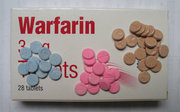Monday
"Yes, yes, yes ... yes, yes," the woman chanted in her high-pitched, singsong voice. During rounds, we were checking in on a patient who is truly beloved by the nursing home staff, the residents, and me. Marta has a number of medical problems, including chronic paranoid schizophrenia, for which she has been in and out of mental health facilities most of her adult life. About three years ago, she suffered a stroke that resulted in complete left-sided hemiplegia. The stroke also caused a severe expressive aphasia, which left her able to say only two words. Luckily, she is in good spirits today, nodding and laughing as she repeats her first word, "yes," over and over again. Regrettably, her second word is not suitable for print. I have heard both words many times over the years and can instantly judge her mood depending on which word she chooses. It is remarkable how a patient can communicate her wants and needs with two simple words. One day she will smile and wave from across the room, exclaiming "Yes, yes, yes!" in such a way that makes me feel like I am her best friend. The next day, if she has a problem, or is upset, that unprintable word is repeated with true conviction. What is most endearing to all of us is that despite tremendous disability, Marta shouts out "yes, yes" a lot more often than the other word.
Tuesday
Everybody feels depressed sometimes, but not usually all the time. I thought about this as I reviewed the chart of my next patient, a 45-year-old woman who suffers from dysthymia. She had been on several antidepressants over the years, with varying success, but lately nothing seemed to help. This patient is a successful woman by other measures--she has a good job (which she does not like) and two grown children who are independent and successful. She always complains that her children rarely visit, but with her gloomy disposition, I can understand why. The patient has tried counseling ("no help"), aerobics ("makes my knees hurt"), meditation ("too strange"), and yoga ("can't concentrate"). I am running out of ideas about how to help her. Luckily, today, she is feeling a little better. "I am going on vacation to Las Vegas," she reported, and went on to describe her trip with some enthusiasm. We talked about her chronic insomnia and achy back for a few minutes, and she left the office with a little smile. I did not write a prescription, order a test, or make a single recommendation. Mostly, we just talked. It seems that some people are born with a pessimistic personality. Every time she comes, I feel lucky for having been born with a normal disposition. I wonder if my children would agree with that statement.
Wednesday
"This 68-year-old man is scheduled for hip replacement surgery in two weeks and is here for surgical clearance," the second-year resident explained in a frustrated voice. I nodded sympathetically. It is indeed a challenge to clear an older patient for surgery, especially during a 15-minute appointment. A review of the patient's chart revealed that he is a healthy man whose only medical problem is well-controlled hypertension. The patient does not smoke and exercises four times per week despite significant hip arthritis. "Ask your nurse to get an electrocardiogram," I recommended, "while I pull up an article on the Internet that will help you." I went to the American Academy of Family Physicians Web site (http://www.aafp.org), typed "preoperative evaluation" into the search engine, and had the article I was looking for. After taking a few minutes to review the article, the resident felt confident about clearing the patient for surgery. "My patient has no cardiac history, only minor clinical predictors of cardiac risk, and good functional capacity," he reported. "I can let the surgeon know today that he is ready to go." I could tell the resident was pleased because what initially seemed like an insurmountable problem was easily solved. "Document your recommendations carefully," was my last bit of advice.
Thursday
The idea of starting an 86-year-old woman on warfarin (coumadin) makes me nervous. This active woman is in wonderful health except for new-onset atrial fibrillation. her thyroid function tests, electrolytes, and echocardiogram are normal. Otherwise, the patient has systolic hypertension that is well controlled with a low-dose diuretic. The emergency department physician started diltiazem (cardizem) for rate control and sent her to see me. "I feel fine," the patient insisted, "but I can assure you that I do not want to have a stroke." This woman knows about strokes because she lives with her younger sister who has been wheelchair bound for more than eight years after a severe stroke. With the help of a dedicated caregiver who comes in every morning, they somehow manage to live independently. My patient feels a tremendous responsibility toward her sister, and any sort of disability would be devastating to them. The risk that an 86-year-old hypertensive woman with atrial fibrillation will have a stroke is in the moderate range (about four strokes per 100 patient-years). After discussing the pros and cons, we decide to start anticoagulation on a trial basis. "You need to come in at least once a week until we get the dose regulated," I warned. Now I will worry about her driving across town to see me every week.
Friday
"I have never seen an HDL cholesterol level this high," I told one of my partners. "This has got to be a mistake." The laboratory results showed a total cholesterol of 270 mg per dL (7.0 mmol per L), low-density lipoprotein (LDL) cholesterol of 102 mg per dL (2.64 mmol per L), triglycerides of 70 mg per dL (0.79 mmol per L), and the high-density lipoprotein (HDL) cholesterol level at a whopping 156 mg per dL (4.03 mmol per L). A review of the patient's chart revealed that six months earlier, the HDL level had been a little lower but still was 143 mg per dL (3.70 mmol per L). I also noticed that the patient takes a statin to lower her lipid levels. It is definitely time to reassess her need for that medication. I know this patient well. She is a 64-year-old, sedentary, overweight woman who smokes a pack of cigarettes daily and has hypertension. According to the National cholesterol Education Program guidelines, her goal LDL cholesterol level is less than 130 mg per dL (3.36 mmol per L). Two years ago, her LDL level was 165 mg per dL (4.27 mmol per L). After a failed trial of diet and exercise, I recommended medical therapy. Even at that time, her HDL level had been a respectable 81 mg per dL (2.09 mmol per L). What a remarkable response she had to medication. When the patient came to the office later that afternoon, I asked about her family history. Not surprisingly, her mother lived to be 87 years old. "You inherited her protective cholesterol," I said. She went on to tell me that her father had died in his early 60s from lung cancer. I stopped marveling about her cholesterol because it suddenly became clear that I needed to invest more energy in persuading this patient to quit smoking.
Saturday/Sunday
This particular patient has a large thyroid nodule. The problem would be simple enough, except that she is 78 years old with severe dementia. She lives with her daughter, but recently we have discussed the need for her to go to a long-term care facility. "Mother is more difficult to live with every day," her daughter explains. "She is constantly pacing around the house, trying every door, as if she is trying to escape." The patient smiles sweetly at me from the examination table, then gets down and walks out the door. I redirect her to another chair while I try to decide what to do. The nodule on her thyroid is cystic, and her thyroid function tests are normal. Under ordinary circumstances, a fine-needle biopsy would be a simple procedure, but the radiologist went out of the way to note on the ultrasound report, "Because of the patient's extreme restlessness, this nodule cannot be biopsied." As I reviewed the report, the patient shouldered by me and opened the examination room door. Signaling to one of the nurses to follow her, I sat down and explained to the daughter that there is about a 5 percent chance that the nodule is malignant. The question in this case, is whether it would be worth the risk to sedate her mother for the biopsy. After some discussion, the daughter opted for watchful waiting. "That is what I would recommend," I said. "If you reconsider, let me know."
Kathy Soch, M.D., is a clinical instructor with the Corpus Christi (Texas) Family Residency Program, affiliated with the University of Texas Health Science Center in San Antonio. This community-based program, which employs nine full-time faculty and 36 residents, primarily serves low-income, uninsured patients.
Address correspondence to Kathy Soch, M.D., 2606 Hospital Blvd., Corpus Christi, TX 78405.
To preserve patient confidentiality, the patients' names and identifying characteristics have been changed in each scenario. Any resemblance to actual persons is coincidental.
COPYRIGHT 2005 American Academy of Family Physicians
COPYRIGHT 2005 Gale Group



